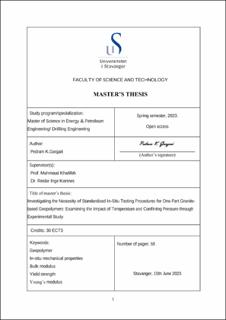| dc.description.abstract | Ordinary Portland cement (OPC) is widely used in primary cementing and plug and abandonment operations due to its well-known properties, global availability, and affordability. However, it has limitations and durability concerns in corrosive downhole environments. Additionally, OPC contributes significantly to global CO2 emissions (6-8 wt.%). Consequently, industries are exploring alternative cementitious materials that offer comparable or superior fluid-state and physical properties while being more economically viable and
environmentally sustainable.
Geopolymer cement (GPC) is an inorganic polymer with binding properties, forming a 3D network structure of silicate and aluminum. GPC exhibits stability at high temperatures, increased durability in corrosive environments, greater flexibility, and lower matrix permeability compared to OPC. Although these advantages make GPC an excellent alternative to OPC, its application in oilfields is still limited to laboratory-scale experiments due to the young age of the technology.
This study is complementary to two other projects being conducted to reveal the potential necessity of standard procedures for testing in-situ rock mechanical properties of the GPC. Since the impact of pore pressure and loading rate is covered in the other two projects, this work presents the effect of temperature and confining pressure on the in-situ mechanical properties of the one-part granite-based geopolymer cement. A triaxial cell is used to analyze Young’s modulus, bulk modulus, Poisson’s ratio, and compressive strength of the material at three different temperatures and confining pressure.
The GPC sample preparation procedure is optimized during the study after experiencing inconsistent and unreliable results during the first seven tests. The increase in test temperature resulted in a decrease in yield strength, peak stress, and Young’s modulus while causing an increase in the bulk modulus. The sensitivity of the material to temperature decreases with the increase of confining pressure. The increase in confining pressure also increased the yield strength and peak stress of the material. | |
